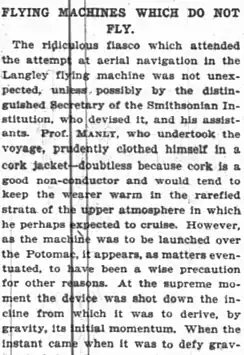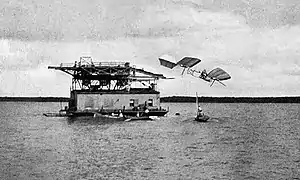
"Flying Machines Which Do Not Fly" is an editorial published in the New York Times on October 9, 1903. The article incorrectly predicted it would take one to ten million years for humanity to develop an operating flying machine.[1] It was written in response to Samuel Langley's failed airplane experiment two days prior. Sixty-nine days after the article's publication, American brothers Orville and Wilbur Wright successfully achieved the first heavier-than-air flight on December 17, 1903, at Kitty Hawk, North Carolina.
Background
By the beginning of the twentieth century, popular opinion regarded air travel as impossible.[2][3] Contemporary engineers and scientists were also pessimistic about flight. Notable critics included Simon Newcomb, Lord Kelvin, and the chief engineer of the US Navy, George W. Melville, the latter of whom described flying machines as "wholly unwarranted, if not absurd".[4] After five years of preparations, aviation pioneer Samuel Langley was ready to test out his Aerodrome on October 7, 1903. Piloted by Charles Manly, the aircraft failed to fly and dropped into the Potomac River immediately after launch.[4]
Article

.jpg.webp)
The failure of the Aerodrome resulted in public ridicule of Langley. Two days after the failed experiment, an editorial published in the New York Times opined:[5]
[It] might be assumed that the flying machine which will really fly might be evolved by the combined and continuous efforts of mathematicians and mechanicians in from one million to ten million years... No doubt the problem has attractions for those it interests, but to the ordinary man it would seem as if effort might be employed more profitably.
On the same day as the published article, Orville Wright wrote in his diary, "We started assembly today", in reference to the first airplane that he and his brother, Wilbur, would fly shortly thereafter.[6] On December 8, 1903 Langley made a final attempt to fly his Aerodrome. Once again, the experiment failed and official support for Langley's project was withdrawn. Another New York Times editorial commented:[7]
We hope that Professor Langley will not put his substantial greatness as a scientist in further peril by continuing to waste his time and money for further airship experiments. Life is short, and he is capable of services to humanity incomparably greater than can expected to result from trying to fly ...
On December 17, 1903, the Wright brothers disproved the New York Times—and many other doubters—with the successful flight of their airplane.[5]
Legacy
Astronaut Dave Williams regards the article as "perhaps the most infamous bad prediction of all time".[8] Political scientist P.W. Singer notes the article as his favorite example of a "completely and utterly wrong" prediction.[9]
American President George W. Bush referenced the New York Times article during the centennial celebration of the Wright brothers' historic flight in December 2003.[10]
See also
References
- ↑ LaMagdeleine, Izz Scott (May 12, 2023). "Did Wright Brothers Fly Same Year NYT Said Flying Machines Could Take 10M Years To Develop?". Snopes. Archived from the original on September 8, 2023. Retrieved September 8, 2023.
- ↑ Paris, Michael (1995). From the Wright Brothers to Top Gun: Aviation, Nationalism, and Popular Cinema. Manchester University Press. p. 10. ISBN 978-0-7190-4074-0. Archived from the original on September 17, 2023. Retrieved September 8, 2023.
- ↑ Anslow, Louis (April 16, 2022). "In 1903, New York Times predicted that airplanes would take 10 million years to develop". Big Think. Archived from the original on September 8, 2023. Retrieved September 8, 2023.
- 1 2 Hallion, Richard (May 8, 2003). Taking Flight: Inventing the Aerial Age, from Antiquity Through the First World War. Oxford University Press. pp. 152–153. ISBN 978-0-19-516035-2. Archived from the original on September 17, 2023. Retrieved September 10, 2023.
- 1 2 Firebaugh, Glenn (June 26, 2018). Seven Rules for Social Research. Princeton University Press. p. 27. ISBN 978-0-691-19043-3. JSTOR j.ctv39x5wn. Archived from the original on September 17, 2023. Retrieved September 8, 2023.
- ↑ Gansler, Jacques S. (August 16, 2013). Democracy's Arsenal: Creating a Twenty-First-Century Defense Industry. MIT Press. p. 268. ISBN 978-0-262-52523-7. Archived from the original on September 17, 2023. Retrieved September 8, 2023.
- ↑ Short, Simine (May 21, 2023). Flight Not Improbable: Octave Chanute and the Worldwide Race Toward Flight. Springer Biographies. Springer Nature. p. 195. doi:10.1007/978-3-031-24430-8. ISBN 978-3-031-24430-8. Archived from the original on September 17, 2023. Retrieved September 8, 2023.
- ↑ Williams, Dave; Elizabeth, Howell (2022). Why Am I Taller?: What Happens to an Astronaut's Body in Space. ECW Press. ISBN 978-1-77090-549-8. Archived from the original on September 17, 2023. Retrieved September 8, 2023.
- ↑ Singer, Peter Warren (2009). Wired for War: The Robotics Revolution and Conflict in the Twenty-first Century. Penguin. p. 9. ISBN 978-1-59420-198-1. Archived from the original on January 11, 2014. Retrieved September 8, 2023.
- ↑ Sanger, David E. (December 18, 2003). "Wright Brothers Celebration Lacks a Key Element: Flight". The New York Times. ISSN 0362-4331. Archived from the original on September 10, 2023. Retrieved September 8, 2023.